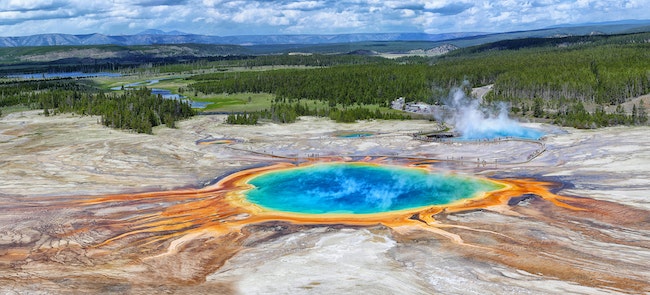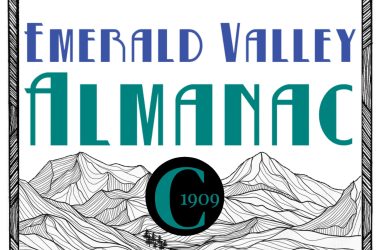
As spring and summer open up and we consider taking a one- or two-week vacation with social distancing in mind, we are blessed in the Northwest with many national parks. Oregon has Crater Lake, while Washington state has three – Mt. Rainer, Olympic, and North Cascades.
Let us consider Yellowstone as a destination, too. Yellowstone is one of 63 premier national parks.
There are 423 national parks in the United States, Puerto Rico, Guam, Virgin Islands and Samoa. Along with that, there are 129 national monuments.
Yellowstone National Park is 96% located in Wyoming. 3% in Montana and 1% in Idaho. It borders a second national park, the Tetons, located in Wyoming.
The first white man to discover Yellowstone was John Colter, a fur trapper. He traveled with the Lewis and Clark Expedition to the Pacific. On the way back, he left the group and followed the Missouri River back up to the eastern edge of Montana, where the Yellowstone flows into the Missouri. Colter followed the Yellowstone River up into what we know today as Yellowstone National Park.
When he returned to what was then civilization and told everyone what he had seen – boiling mud pots, geysers, steaming hot emerald pools – his peers felt he was delusional. This is where Colter’s Hell originated.
President Ulysses S. Grant signed the papers making Yellowstone the first U.S. National Park on March 1, 1872. The park consists of 2,219,791 acres. It is debatable among historians of the exact route that John Colter took entering Yellowstone 1807-08. Half the world’s hydrothermal is present in Yellowstone National Park. More than 10,000 hydrothermal features, such as mud pots, geysers, and emerald pools, are present.
On a one-day drive through Yellowstone a visitor can see many of the highlights. But so many of the features are viewed only by trail. Yellowstone is a hiker’s paradise. Most of the hiking trails are in excellent shape and are easy walking.
For instance, most people view the Falls of the Grand Canyon of the Yellowstone from Artists’ Point. It is most common to see painters’ easels and photographers at this point. There are many hiking trails that go around and up above the falls. You must take a road up to the large parking lot at the south rim and a short trail to the Upper Falls of the Grand Canyon.
If you walk down the trail, past the Upper Falls, you come to the Middle Falls. Another trailhead is Uncle Tom’s Point. These are easy trails, and the colors are brilliant and beautiful.
The Grand Canyon of Yellowstone is 1,000 feet deep and varies in width from 1,500-4,000 feet wide. It is 20 miles long, and is the headwaters for the Yellowstone River. You will often see deer, eagles and other birds and animals. Occasionally some of the trails are closed due to bear sightings, but that is rare.
The falls drain into Yellowstone Lake, and the outlet of the lake is at Fishing Bridge, in the central part of the park, where the Yellowstone River continues.
The Yellowstone flows through the entire state of Montana, along the eastern border and joins the Missouri. The Missouri River is formed at Three Forks, Mont., by three rivers coming together, the Jefferson, the Madison, and Gallatin. (We will discuss Madison River Valley in a future article.)
These three rivers are all formed in the western part of Montana, east of the Continental Divide, and are just a few miles from Yellowstone country.
I’ve been through Yellowstone many times, and as a youngster, with lots of family; we spent time hiking many trails, and getting a feel of the country.
In the mid 1940s there was an abundance of deer and elk, many black bears, and it was not uncommon to see a grizzly or cinnamon bear each day. Buffalo were rare at that time. Today, it is the other way around – you see few bears, but lots of buffalo.
Yellowstone is famous for wolves, lynx, deer, elk, and some moose. Fishing is abundant. There are many fine campsites. If you are traveling on a budget, camping is the way to go, particularly July, August, and September. This area is over 8,000 feet elevation. The nights may be chilly.
When camping, we would spend a few days outside, then get a motel or cabin so we could have a shower and get cleaned up. The Old Faithful Lodge is one of the most rustic in the National Park system. It is all log, and the massive grandfather clock in the main lodge is two stories tall. The Lodge is booked far ahead.
If you have plans for cabins, motels, or the lodge, it is best to go online and make reservations.
Grocery provisions are mostly available throughout the park and at each of the five entrances
While visiting Yellowstone, you must reserve at least a day to visit the Grand Tetons National Park. It is 25 miles from Yellowstone Park to Teton Park.
We in the Northwest enjoy beautiful mountain ranges of different shapes and colors. The Grand Tetons are totally different than we have here in the Cascade Range. A beautiful lush valley and some of the largest elk herds are found in the Jackson Hole/Teton area.
If you have time, go east from Jackson Hole down through some of the most beautiful grassland in the world.
Near the eastern border, turn north to Devils’ Tower, a national monument. The motion picture, “Close Encounters of the Third Kind,” was filmed at Devils’ Tower. From there, head northwest and take in Custer’s Battlefield at Custer, Mont. From there, double back to Bighorn Lake and Recreation area on the highway to Cody, Wyo. Bighorn Canyon National Recreation Area and Bighorn Lake, Fort Smith, Mont., is famous for its wildlife, wild horses, beautiful towering cliffs, miles of hiking trails, mountain sheep, recreational boating, all located on a beautiful lake with many dude ranches and vivid colors.
Of course, you want to spend a couple of days in Cody and visit the Buffalo Bill Museum. There is so much history of the Indian Nations and the movement west headed by the fur trappers, Hudson Bay, frontiersmen, and the railroads. It is a magnificent world-class museum, complete with Native American villages. There are several shows a day, one of them with live raptors. There are so many things to see and do in this town.
There are plenty of stories of John Colter connected with Cody in his fur-trapping days.
In our trips to Yellowstone, we have encountered many bears – all good meetings. In a trip my father and I took in 1954, we pulled off at a turnout – there were several bears in the area. We had a sack of small apples, and my dad rolled an apple across the parking lot and the bear chased it – we emptied the bag of apples feeding the bear – something we absolutely DO NOT DO TODAY.
In Sept. 1958, my wife Jean and I were traveling with my folks in a four-door Pontiac. We pulled into a trailhead parking lot, and there was a mother black bear with three cubs. There were several garbage cans – one 55-gallon can did not have a cover. One of the cubs was standing on top of the rim, looking down in the can. The mother bear was looking at the other cans, and the cubs were looking on. There were several cars with people and cameras, taking pictures. I had about 10 feet of film left on my movie roll. I got movies of the four bears when my film ran out. I had the camera on the trunk, changing film. At the same time, a woman two parking spots over, also ran out of film, and she sat in the front passenger seat, looking down, changing film, when the mother bear walked over to her car, stood up on its hind feet, put paws on window ledge, and when the lady looked up, their noses were about five inches apart. She screamed, and I think the car had power windows – because it went up fast, and the bear jumped down and ran back to her cubs!
And, of course, I did not get movies of this scene!






